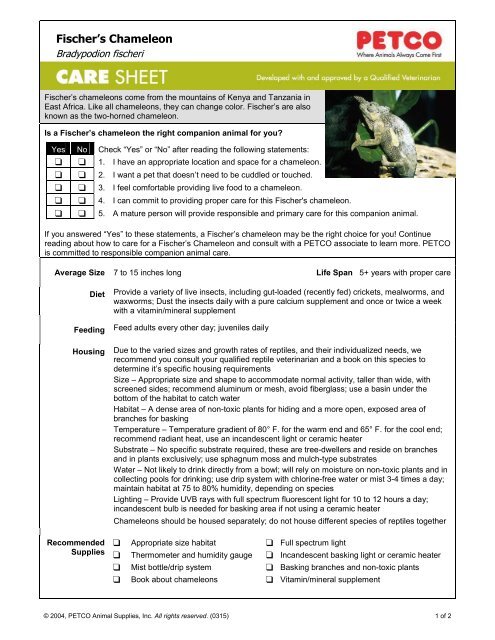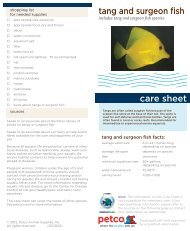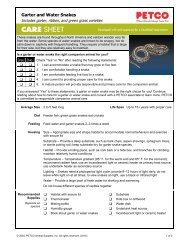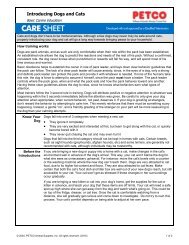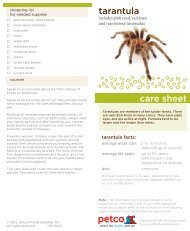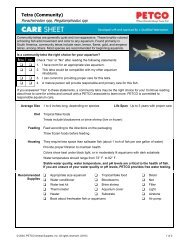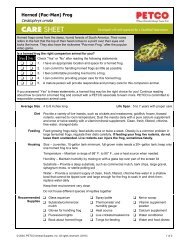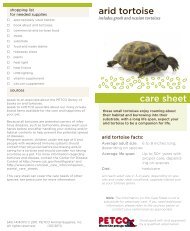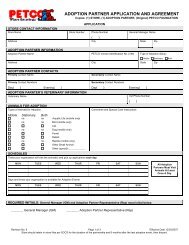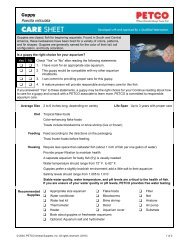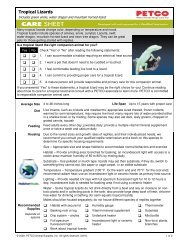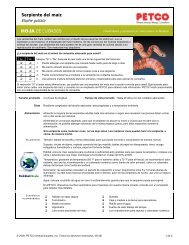Fischer's Chameleon - Petco
Fischer's Chameleon - Petco
Fischer's Chameleon - Petco
Create successful ePaper yourself
Turn your PDF publications into a flip-book with our unique Google optimized e-Paper software.
Fischer’s <strong>Chameleon</strong>Bradypodion fischeriFischer’s chameleons come from the mountains of Kenya and Tanzania inEast Africa. Like all chameleons, they can change color. Fischer’s are alsoknown as the two-horned chameleon.Is a Fischer’s chameleon the right companion animal for you?Yes No Check “Yes” or “No” after reading the following statements:❑ ❑ 1. I have an appropriate location and space for a chameleon.❑ ❑ 2. I want a pet that doesn’t need to be cuddled or touched.❑ ❑ 3. I feel comfortable providing live food to a chameleon.❑ ❑ 4. I can commit to providing proper care for this <strong>Fischer's</strong> chameleon.❑ ❑ 5. A mature person will provide responsible and primary care for this companion animal.If you answered “Yes” to these statements, a Fischer’s chameleon may be the right choice for you! Continuereading about how to care for a Fischer’s <strong>Chameleon</strong> and consult with a PETCO associate to learn more. PETCOis committed to responsible companion animal care.Average Size 7 to 15 inches long Life Span 5+ years with proper careDietFeedingHousingRecommendedSuppliesProvide a variety of live insects, including gut-loaded (recently fed) crickets, mealworms, andwaxworms; Dust the insects daily with a pure calcium supplement and once or twice a weekwith a vitamin/mineral supplementFeed adults every other day; juveniles dailyDue to the varied sizes and growth rates of reptiles, and their individualized needs, werecommend you consult your qualified reptile veterinarian and a book on this species todetermine it’s specific housing requirementsSize – Appropriate size and shape to accommodate normal activity, taller than wide, withscreened sides; recommend aluminum or mesh, avoid fiberglass; use a basin under thebottom of the habitat to catch waterHabitat – A dense area of non-toxic plants for hiding and a more open, exposed area ofbranches for baskingTemperature – Temperature gradient of 80° F. for the warm end and 65° F. for the cool end;recommend radiant heat, use an incandescent light or ceramic heaterSubstrate – No specific substrate required, these are tree-dwellers and reside on branchesand in plants exclusively; use sphagnum moss and mulch-type substratesWater – Not likely to drink directly from a bowl; will rely on moisture on non-toxic plants and incollecting pools for drinking; use drip system with chlorine-free water or mist 3-4 times a day;maintain habitat at 75 to 80% humidity, depending on speciesLighting – Provide UVB rays with full spectrum fluorescent light for 10 to 12 hours a day;incandescent bulb is needed for basking area if not using a ceramic heater<strong>Chameleon</strong>s should be housed separately; do not house different species of reptiles together❑ Appropriate size habitat ❑ Full spectrum light❑ Thermometer and humidity gauge ❑ Incandescent basking light or ceramic heater❑ Mist bottle/drip system ❑ Basking branches and non-toxic plants❑ Book about chameleons ❑ Vitamin/mineral supplement© 2004, PETCO Animal Supplies, Inc. All rights reserved. (0315) 1 of 2
Fischer’s <strong>Chameleon</strong>Bradypodion fischeriNormalBehavior andInteractionHabitatMaintenanceGroomingand HygieneAll chameleons change color, depending on temperature and moodFischer’s males have inch-long, horn-like projections on their snout; they are much larger thanthe femalesMost chameleons become very stressed when handled; only handle when necessaryRemove feces from habitat daily; mist frequently to maintain humidityThoroughly clean the habitat at least once a week: set chameleon aside in a secure habitat;scrub the habitat with a 3% bleach solution; rinse thoroughly with water, removing all smell ofbleach; add clean substrateAlways wash your hands before and after touching your chameleon or habitat contents to helpprevent Salmonella and other infectious diseases<strong>Chameleon</strong>s regularly shed their skin; mist regularly to ensure proper humidity for sheddingSigns of aHealthy Animal Consistent behavior Eats regularly Healthy skin Clear nose and vent Clear eyes Body and tail are rounded and fullCommonHealth IssuesHealth Issue (alpha) Symptoms or Causes Suggested ActionGastro-intestinalDiseaseMetabolicBone/VitaminDeficiencyRespiratory DiseaseRunny stools, caked or smearedstool around the vent area, and lossof appetite caused by bacterial orparasitic infection.Inability to absorb calcium due toinsufficient UVB light. If untreated,can lead to a disorder characterizedby deformities and softened bones.Swollen limbs and lethargy.Labored breathing, runny nose,swollen eyes. Can be caused bytemperatures that are too cold.Consult your exotic animalveterinarian.Provide ample UVB lightingand consult your exoticanimal veterinarian.Ensure that the habitat isappropriately warm. Consultyour exotic animalveterinarian.Red Flags Mucus in mouth or nose Lethargic Swelling Labored breathing Paralysis of limbs or tail Abnormal feces Bumps, sores or abrasions on skin Weight loss or decreased appetiteIf you notice any of these signs, please contact your exotic animal veterinarian.Sources<strong>Chameleon</strong>s, Their Care and Breeding by Linda J. DavisonThe New <strong>Chameleon</strong> Handbook by Francois Le BerreNote: The information on this Care Sheet is not a substitute for veterinary care. If you need additionalinformation, please refer to the above sources or contact your veterinarian as appropriate.2 of 2 SKU 942561 © 2004, PETCO Animal Supplies, Inc. All rights reserved. (0315)


